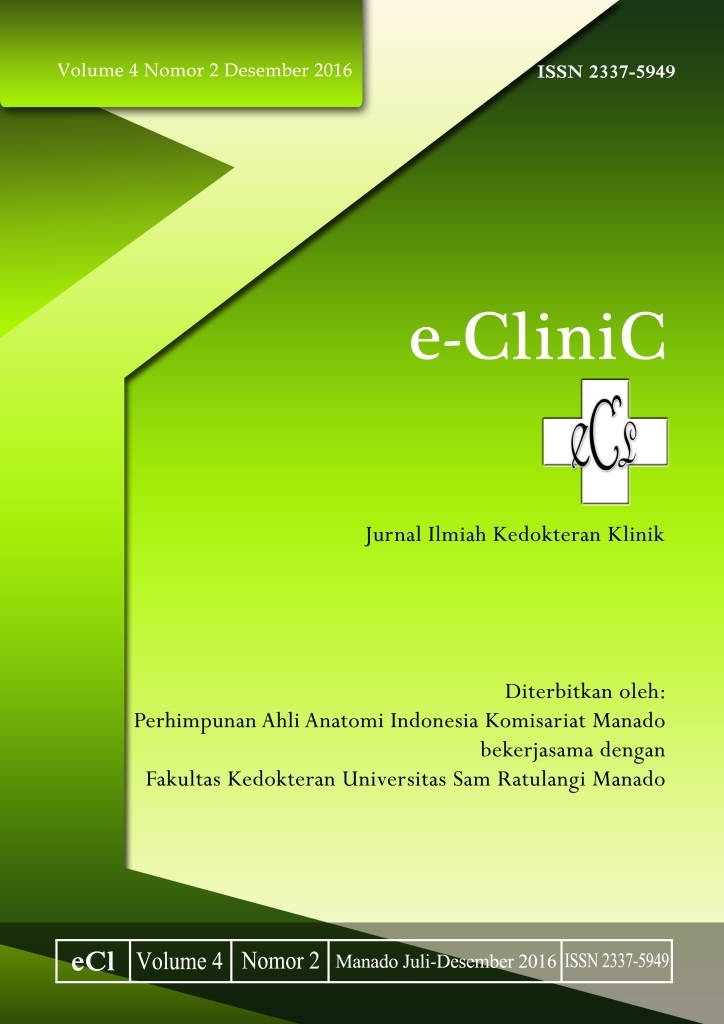Perbandingan antara ondansetron 4 mg iv dan deksametason 5 mg iv dalam mencegah mual-muntah pada pasien laparotomi dengan anestesia umum
DOI:
https://doi.org/10.35790/ecl.v4i2.14559Abstract
Abstract: Nausea and vomiting are the most frequent side effects which occur postoperatively as a result of general anesthesia. Postoperative nausea and vomiting may increase morbidity and extend the duration of patient to stay at the recovery room. Ondansetron drug that has the effect as 5-HT3 antagonist receptor and dexamethasone administration might be the drug of choice in preventing postoperative nausea and vomiting. This study was aimed to compare the effect of 4 mg ondansetron and 5 mg dexamethasone administration on the incidence of postoperative nausea and vomiting in laparotomy surgery with general anesthesia. This was a prospective analytical study with an experimental method. Samples were obtained by using consecutive random sampling. There were 32 patients aged 18 to 60 years old, ASA I-II clasification, divided into two treatment groups as follows: ondansetron group given at the end of operation and dexamethasone group given before the induction of anesthesia. The resultas showed that complaints of postoperative nausea and vomiting mostly occured at the 5 mg dexamethasone group (37.5%) rather than 4 mg ondansetron group (12.5%). The Mann-Whitney test showed that there were no significant difference between both groups (p>0.05). Conclusion: Administration of 4 mg ondansetron intravenously has the same effectivity as 5 mg dexamethasone intravenously in reducing the incidence of postoperative nausea and vomiting after laparotomy with general anesthesia.
Keywords: nausea and vomiting, ondansetron, dexamethasone
Â
Abstrak: Mual-muntah merupakan efek samping yang paling sering didapatkan pasca operasi akibat pemberian anestesia umum. Mual-muntah pasca operasi dapat meningkatkan morbiditas dan memperpanjang masa rawat pasien dari ruang pulih. Pemberian obat ondansetron yang berefek 5-HT3 reseptor dan deksametason dapat menjadi obat pilihan dalam mencegah terjadinya mual muntah pascaoperasi. Penelitian ini bertujuan untuk membandingkan pemberian ondanetron 4 mg dan deksametason 5 mg terhadap kejadian mual-muntah pasca operasi pada bedah laparotomi dengan anestesia umum. Jenis penelitian ialah analitik prospektif dengan metode eksperimental. Sampel didapatkan secara consecutive random sampling yang dilakukan pada 32 pasien dengan rentang usia 18-60 tahun, klasifikasi ASA I-II, yang dibagi menjadi dua kelompok perlakuan: kelompok ondansetron yang diberikan di akhir operasi dan kelompok deksametason sebelum induksi anestesia. Hasil penelitian mendapatkan keluhan mual muntah pascaoperasi lebih banyak terjadi pada kelompok deksametason 5 mg (37,5%) dibandingkan kelompok ondansetron 4 mg (12,5%). Uji Mann-Whitney mendapatkan tidak ada perbedaan bermakna antara keduanya (p >0,05). Simpulan: Pemberian ondansetron 4 mg intravena memiliki efektivitas yang sama dengan deksametson 5 mg iv dalam menurunkan kejadian mual-muntah pasca operasi laparotomi dengan anestesia umum.
Kata kunci: mual muntah, ondansetron, deksametason
Downloads
How to Cite
Issue
Section
License
COPYRIGHT
Authors who publish with this journal agree to the following terms:
Authors hold their copyright and grant this journal the privilege of first publication, with the work simultaneously licensed under a Creative Commons Attribution License that permits others to impart the work with an acknowledgment of the work's origin and initial publication by this journal.
Authors can enter into separate or additional contractual arrangements for the non-exclusive distribution of the journal's published version of the work (for example, post it to an institutional repository or publish it in a book), with an acknowledgment of its underlying publication in this journal.
Authors are permitted and encouraged to post their work online (for example, in institutional repositories or on their website) as it can lead to productive exchanges, as well as earlier and greater citation of the published work (See The Effect of Open Access).







